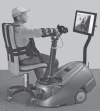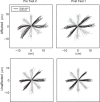Robotic therapy for chronic stroke: general recovery of impairment or improved task-specific skill?
- PMID: 26180120
- PMCID: PMC4575974
- DOI: 10.1152/jn.00336.2015
Robotic therapy for chronic stroke: general recovery of impairment or improved task-specific skill?
Abstract
There is a great need to develop new approaches for rehabilitation of the upper limb after stroke. Robotic therapy is a promising form of neurorehabilitation that can be delivered in higher doses than conventional therapy. Here we sought to determine whether the reported effects of robotic therapy, which have been based on clinical measures of impairment and function, are accompanied by improved motor control. Patients with chronic hemiparesis were trained for 3 wk, 3 days a week, with titrated assistive robotic therapy in two and three dimensions. Motor control improvements (i.e., skill) in both arms were assessed with a separate untrained visually guided reaching task. We devised a novel PCA-based analysis of arm trajectories that is sensitive to changes in the quality of entire movement trajectories without needing to prespecify particular kinematic features. Robotic therapy led to skill improvements in the contralesional arm. These changes were not accompanied by changes in clinical measures of impairment or function. There are two possible interpretations of these results. One is that robotic therapy only leads to small task-specific improvements in motor control via normal skill-learning mechanisms. The other is that kinematic assays are more sensitive than clinical measures to a small general improvement in motor control.
Keywords: kinematics; motor control; neurorehabilitation; robotic therapy; stroke.
Copyright © 2015 the American Physiological Society.
Figures





References
-
- Bavelier D, Green CS, Pouget A, Schrater P. Brain plasticity through the life span: learning to learn and action video games. Annu Rev Neurosci 35: 391–416, 2012. - PubMed
-
- Bayona NA, Bitensky J, Salter K, Teasell R. The role of task-specific training in rehabilitation therapies. Top Stroke Rehabil 12: 58–65, 2005. - PubMed
-
- Beer RF, Dewald JP, Rymer WZ. Deficits in the coordination of multijoint arm movements in patients with hemiparesis: evidence for disturbed control of limb dynamics. Exp Brain Res 131: 305–319, 2000. - PubMed
-
- Cirstea MC, Mitnitski AB, Feldman AG, Levin MF. Interjoint coordination dynamics during reaching in stroke. Exp Brain Res 151: 289–300, 2003. - PubMed
Publication types
MeSH terms
Grants and funding
LinkOut - more resources
Full Text Sources
Other Literature Sources
Medical

